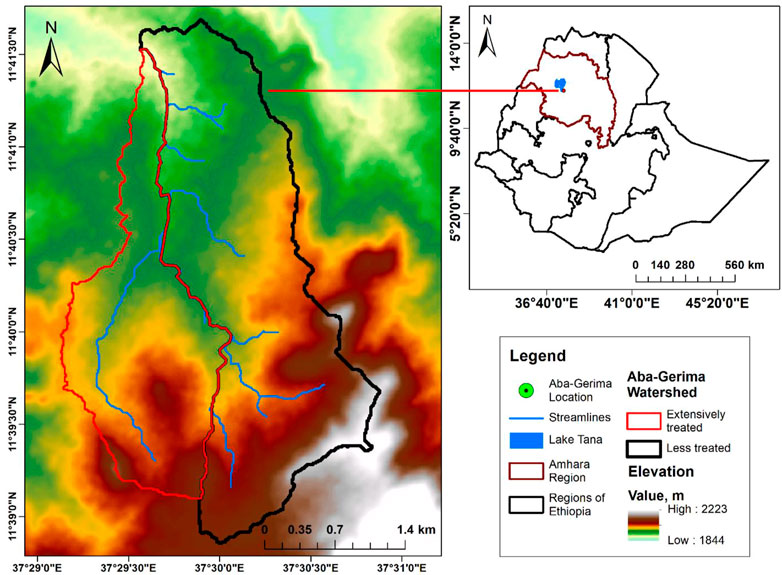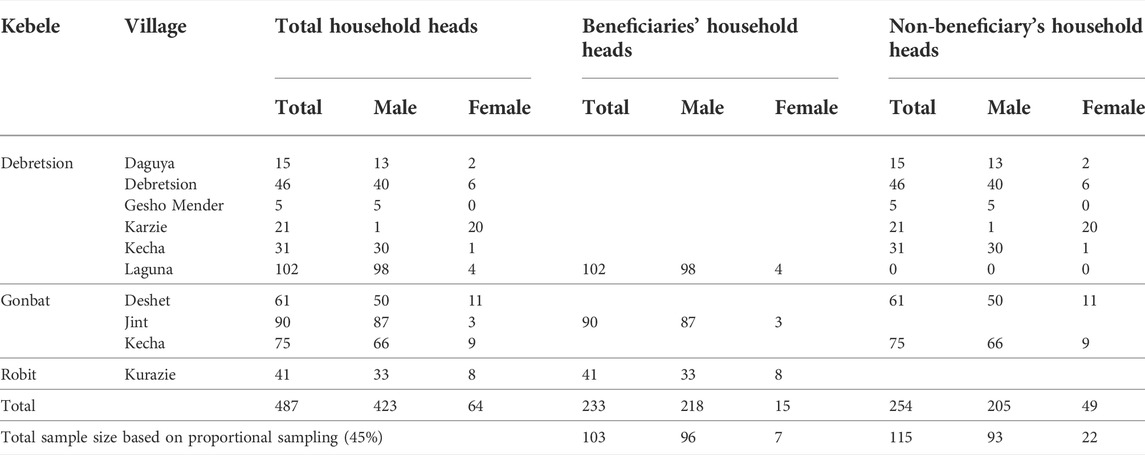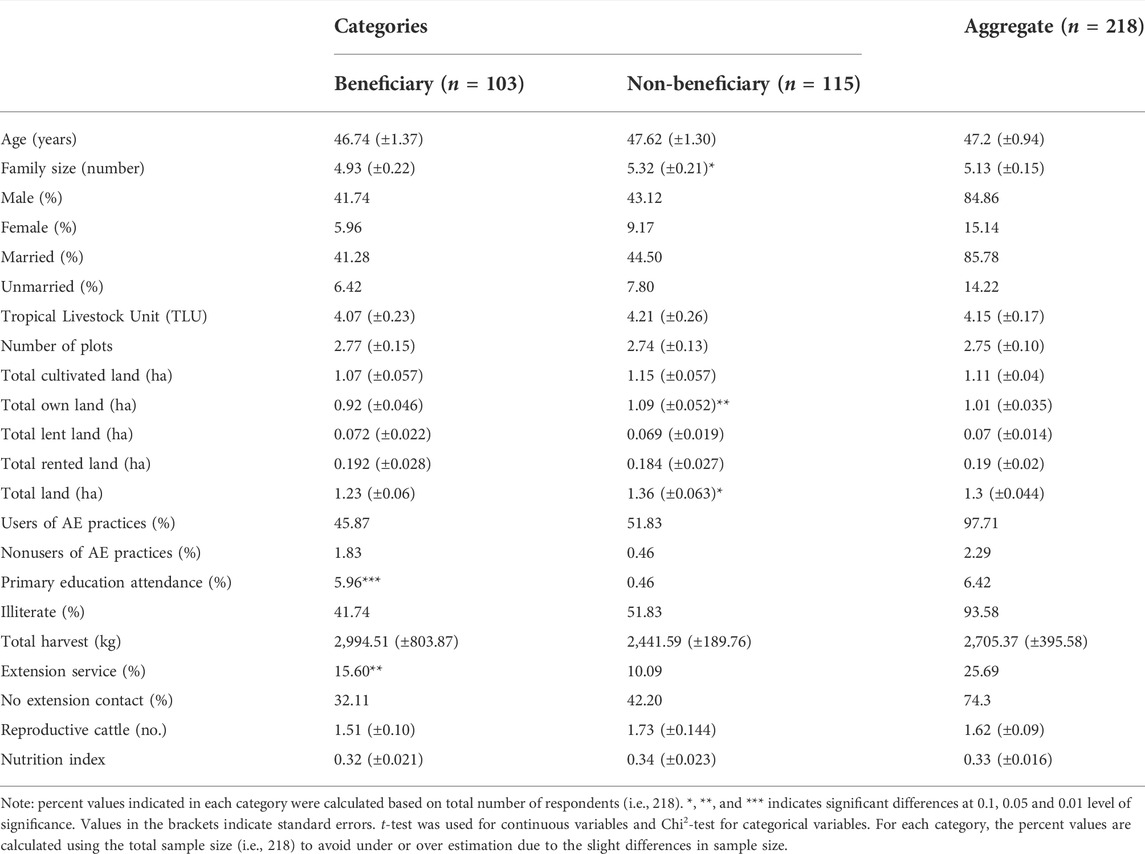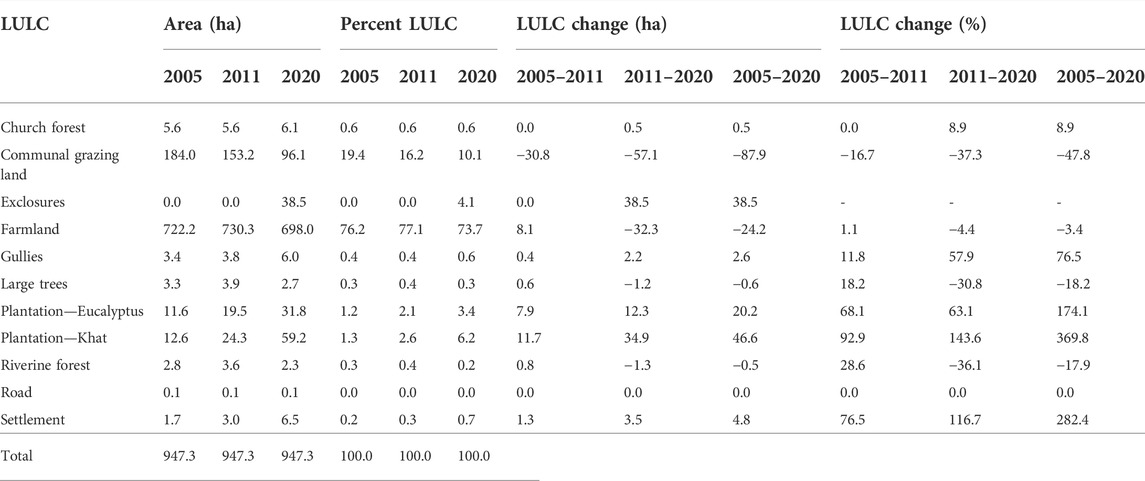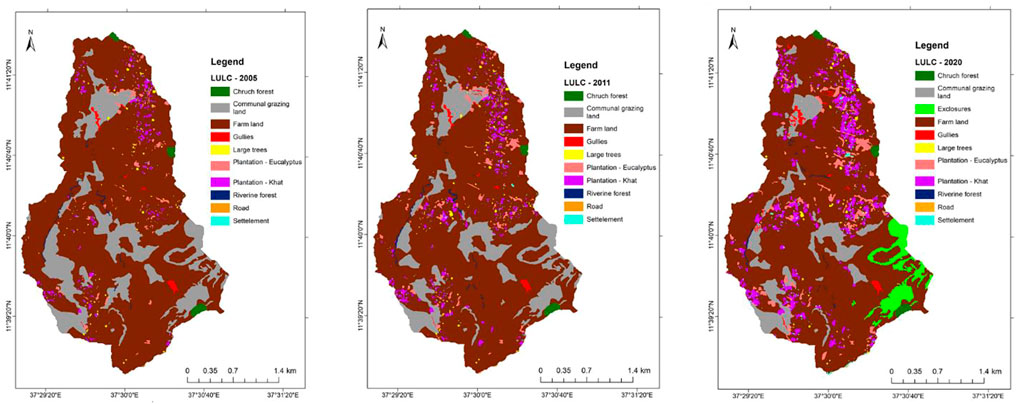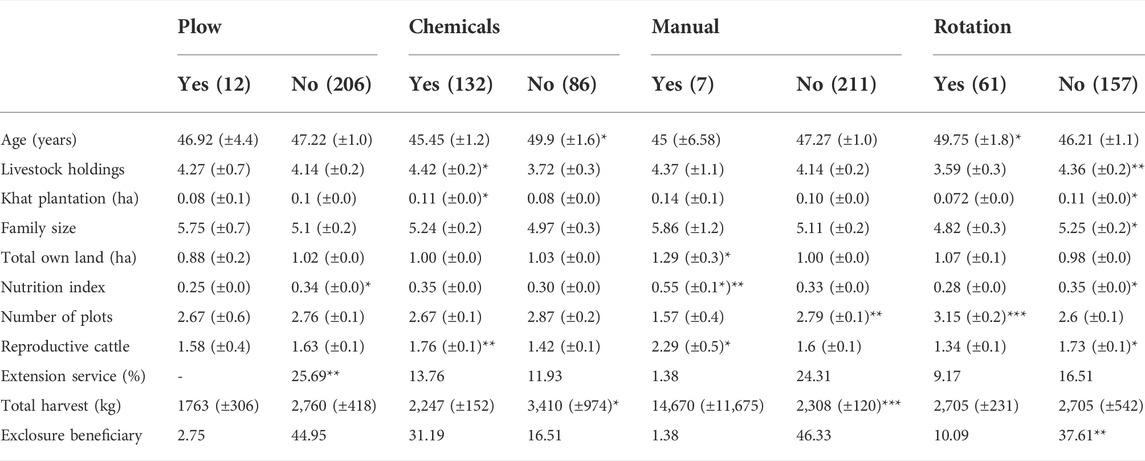- 1International Water Management Institute (IWMI), Addis Ababa, Ethiopia
- 2Amhara Agricultural Research Institute (ARARI), Bahir-Dar, Ethiopia
- 3Bahir-Dar University, College of Agriculture and Environmental Science, Bahir-Dar, Ethiopia
- 4Ethiopian Environment and Forest Research Institute, Addis Ababa, Ethiopia
The challenges to agroecological transitions are not the same for all farmers and implementation of agroecological practices in different locations could yield different results. With this consideration, this study was conducted in Aba-Garima watershed in northwestern Ethiopia to characterize the structure and activities of farming households and assess factors influencing the implementation and sustainability of agroecological practices. Data were collected from 218 households, 16 key informants, and 12 focus group discussions. The Multivariate Probit model and descriptive statistics were employed to analyze factors influencing farmers’ choices of different agroecological practices and describe the characteristics of farming households. The qualitative data analysis was processed through topic coding and building categories, themes, and patterns of relationships. Farmers realize the importance of both farm and landscape level agroecological practices to enhance income earning capacity, achieve food security and protect the environment. However, most of the agroecological practices are very difficult to start using for various constraining factors including limited access to water, and shortages of money, land and labor. The results suggest that depending on different socio-economic characteristics of farming households, agroecological practices that appear common practices can be very difficult to use for some farmers, while it would be possible for other farmers. The constraining factors are also differently associated with different practices, involving diverse perspectives of different socio-economic groups. The paper discussed the existing agroecological practices, the perspectives of different socio-economic groups on these practices and the factors influencing the implementation as well as the conditions that can facilitate the wider adoption of agroecological practices in the study area.
Introduction
With the growing world population, agricultural land and water resources are becoming scarcer, and there has been an increasing tendency and need to produce more on the remaining land. However, producing more for a growing population is constrained by different forms of land degradation, and excessive and/or inappropriate agrochemicals use (Dellink and Ruijs 2008; Sutton et al., 2013). In Sub-Saharan Africa, continuous cultivation without adequate replenishment of soil nutrient leads to widespread soil nutrient mining and losses (e.g., Haileslassie et al., 2006), while many grazing lands are in a degraded state, affecting productivity, household incomes, and environmental health, thereby trapping people in poverty (Kemp et al., 2013). On the other hand, while there has been an increasing demand in the last decades to produce larger quantities of food, there is an increasing call towards sustainable agricultural development where production should be environmentally friendly, socially fair, and economically beneficial (Wezel et al., 2014).
Agroecology or the application of social and ecological principles for the design and management of sustainable agroecosystems (Tittonell et al., 2020) is a key part of the global response to achieving the demand for sustainable agricultural development, offering a unique approach to meeting significant increases in our food needs of the future while ensuring no one is left behind (Barrios et al., 2020). Thus, agroecology can promote the transition towards social-ecological sustainability (Oteros-Rozas et al., 2019). Unlike other approaches to sustainable development, agroecology helps to deliver contextualized solutions to local problems. It is based on bottom-up and territorial processes, involving the co-creation of knowledge, and combining science with the traditional, practical, and local knowledge of producers (Barrios et al., 2020). It is characterized by its participatory approach (Méndez et al., 2013).
Following the development of agroecology, the term agroecological practices emerged in the 1980s (Wezel et al., 2009). A review by Wezel et al. (2014), summarized diverse agroecological practices that can be implemented at different scales, from farm or field (e.g., intercropping, crop rotation, diversification of crops, agroforestry, application of compost and manure) to landscape (e.g., sustainable land management practices including physical and biological soil and water conservation measures and water harvesting technologies). These agroecological practices contribute to addressing food insecurity (e.g., Branca et al., 2013; Paracchini et al., 2020) and specific climate change effects such as soil erosion caused by more intensive rainfall, and they also help mitigate higher temperature, and restore vegetation cover at landscape scale (Branca et al., 2013; Sinclair et al., 2019).
The implementation of agroecological practices in Ethiopia and the Aba-Gerima watershed, the study area, concentrated on both family farms at the household level and landscape level (Ayalew 2011; Quinlan et al., 2015). These include intercropping, soil bunds, grass strips, agroforestry systems, diverse polycultures (inter and intraspecies diversity), water conservation practices (water harvesting), integrated crop-livestock systems, integrated pest management, and direct seeding. Some studies (e.g., Asrat and Simane 2017; Schmidt and Tadesse 2019) indicated that these agroecological practices contribute to address food insecurity through increasing crop yield and farm income and helping to improve the environment and biodiversity.
Although these studies have demonstrated the potential contributions of agroecological practices at the household or farm and landscape level, there are several notable limitations and obstacles. For example, agroecological practices are very context-specific and their implementation in a different location could yield different results (Paracchini et al., 2020). In addition, the challenges to agroecological transitions are not the same for all farmers, as they can contend with different social and bio-physical conditions (Teixeira et al., 2018; Etsay et al., 2019). The social and structural characteristics of farms such as assets, social relations, institutions, and organizations also can influence the implementation of agroecological practices and impact the success of agroecological practices. Further, understanding differences among households in terms of access to assets (such as land, capital, water, and labor), patterns of household economic diversification and different economic and institutional environments in which farmers operate, as well as the relations between practices and structural variables and the diversity of farm types are crucial for investigating the socio-economic, technical and organizational patterns that generate different types of agricultural systems. Thus, this study was conducted in the Aba-Gerima watershed, Northwestern Ethiopia to: 1) assess farmers’ perceptions and use of agroecological practices, 2) characterize the structure and activities of farming households and farming practices, 3) assess farmers’ awareness and experiences of implementing agroecological practices, and 4) understand the diversity of farms and factors influencing the implementation of different agroecological practices.
Methods
Study area
Aba-Garima watershed, the study site, is in the Amhara regional state, north-western Ethiopia (Figure 1). It is located between 11°38′51″ and 11°41′42″ N latitude, and between 37°29′8″ and 37°30′52″ E longitude (Figure 1). The mean annual rainfall (for the years 1999–2015) was 1,343 mm y−1 (Abebe et al., 2020). The mean annual temperature varies between 13 and 27°C. The study area covers an area of 947 ha. It is characterized by its mountainous and undulating topographic features. The elevation ranges between 1,648 and 2,578 m above sea level. Leptosols and Luvisols are the major soil types in the watershed.
Farmlands, communal grazing lands, plantations, exclosure, and church forests are the major land use and land covers in Aba-Gerima watershed. Farmlands are the dominant land cover type. For example, major land use and land covers in 2020 include farmlands covering 73.7%, communal grazing lands (10.1%), Khat plantation (6.2%), exclosure (4.1%), eucalyptus plantation (3.4%), and church forest (0.6%). The remaining 2% are covered by riverine forest, big trees, gullies, roads, and settlements.
Farm households in the Aba-Garima watershed are characterized as smallholdings, with an average of 1.25 ha of land and an average livestock holding of 3.84 tropical livestock unit (TLUs) (Abeje et al., 2019). The average landholding is somewhat higher compared to the national average (0.96 ha) (Headey et al., 2014). Land is owned by the state and farmers have use rights. Other forms of informal land tenure systems include sharecropping and lease farming.
People in the Aba-Garima watershed make their livelihood mainly from a subsistent mixed crop-livestock farming system and agriculture is their major source of employment. In addition, a considerable number of households engage in off-farm and non-farm livelihood activities. Livestock has multiple roles to the livelihood of farmers in the study site,. For example, they provide draught power for farming, food, and income through sale of livestock and their products. They also provide employment opportunities and insurance against drought while supplying fuel for cooking (cow dung) and manure for improving soil fertility.
Data collection
The study employed both quantitative and qualitative methods to collect data including key informant interviews (Figure 2), household surveys, focus group discussions (FGD) and land use and land cover analysis.
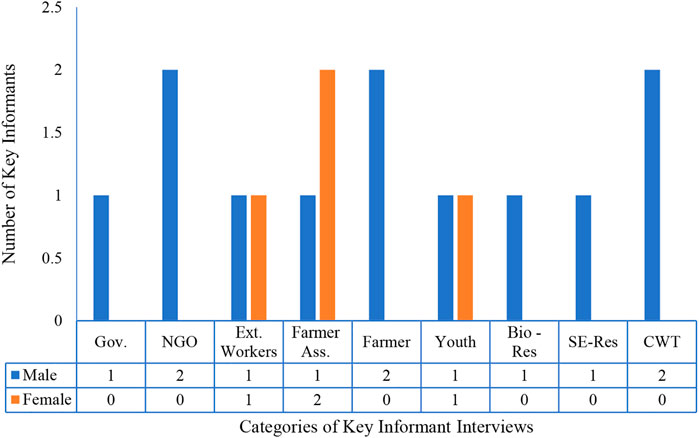
FIGURE 2. Composition of the key informants. Gov. refers to representative of government organization, NGO—non-governmental organization, Ext. Workers—extension/community development workers, farmer refers to knowledgeable farmers, Bio—Res and SE-Res refers to biophysical and socio-economic researchers, respectively, CWT—representative of community watershed team.
The household survey involved 218 randomly selected respondents or households, of which 103 were beneficiaries and 115 were non-beneficiaries. The classification of respondents as beneficiaries and non-beneficiaries refers to the involvement of households in managing, using, protecting, and benefiting from exclosures. The 218 respondents were selected randomly from 8 villages found in the watershed and cover about 45% of the total households (Table 1). Household surveys data from 218 respondents was collected during 28 July to 20 August 2021 using structured and semi-structured questionnaires.
In addition, 12 focus group discussions were conducted. Each FGD group had 8 participants. Participants of the 12 FGD involved different socio-economic categories of farmers from both beneficiaries and non-beneficiaries. Each category (i.e., beneficiaries and non-beneficiaries) was first stratified based on gender, wealth, and farming orientation. Then, participants of FGD were selected from male and female-headed households, poor and rich households, and from households which dominantly practice subsistence and cash crop-oriented farming system. The 12 FGD groups involve 6 beneficiaries’ groups and 6 non-beneficiaries groups). The collection of qualitative data using key informant interviews and FGD was facilitated by a set of interview guides, focus group discussion topics and guides, including participatory formats.
Data analyses
Quantitative data analyses
Data cleaning, organization and validation of model results were done prior to analysis. In addition, the livestock holdings of the respondents were first converted to Tropical Livestock Unit (TLU), which is a common unit used to describe livestock numbers, using the accepted metabolic conversion rates (Ahmed and Mesfin 2017). Then, the quantitative household surveys data was analyzed using both descriptive statistics and Multivariate Probit (MVP) model. The Multivariate Probit model was employed to analyze factors influencing farmers’ choice of different agroecological practices. The MVP model was preferred, as farmers implement more than one agroecological practices and there could be correlations among binary responses of multiple practices and interdependencies among agroecological practices and decisions (Nhemachena and Hassen 2007; Seid 2015). In other words, the selection of one type of agroecological practice could be dependent on the selection of the other, given that household’s decisions are interdependent, suggesting the need to estimate them simultaneously. In line with this, the reality in the study areas is that farmers generally adopt a mix of agroecological practices rather than a single practice. The MVP model also allows to examine whether there is complementarity (positive correlation) and substitutability (negative correlation) among adopted agroecological practices (Greene 2012).
The MVP model is based on the expected utility maximization theory which suggests that individual farmer i will use an agroecological practice if the expected utility from adopted agroecological practice (µ*ij) is greater than the expected utility from any other alternative practices, including the business as usual [i.e., not using any practice, (µij)]. This can be expressed using Eq. 1.
Where y∗ij is the net benefit (latent variable) that the farmer can receive from adopting jth practice.
In this study, the multivariate model consists of six binary choice equations, compost (implemented by 115, 53% of farmers), manure (166, 76%), home garden (84, 38%), natural mating (58, 27%), watershed development activities (185, 85%), and agroforestry practices (69, 32%). The percent values are more than 100% given that a farmer can adopt more than one agroecological practice. These agroecological practices were selected for the MVP analysis as each of the agroecological practice was adopted by more than 25% of the respondents.
The model assumes that each binary observed variable takes a value 1 if the ith farmer adopts agroecological practice j, as well as if and only if, the continuous latent variable is greater than zero:
where yij is the dependent variable; y*ij is a latent variable that captures the unobserved preferences associated with the choice of the six agroecological practices and is influenced by observed characteristics (Xij) and unobserved characteristics captured by the stochastic error term (µij); βij is a vector of estimated parameters of Xij. The error terms µij = 1, 2, 3, 4, 5, 6 is distributed multivariate normal with zero conditional mean (0, Ω) and a variance covariance matrix Ω is value of 1 on the leading diagonal and correlations ρij = ρji as off-diagonal elements.
where ρ(rho) denotes the pairwise correlation between error terms. If the correlations of the error terms shown in the off-diagonal elements of the variance-covariance matrix become non-zero, then Eq. 3 becomes a MVP model. Thus, off-diagonal elements show correlation between the different types of agroecological practices.
Qualitative data and land use and land cover analyses
The qualitative data analysis was processed through topic coding and building categories, themes, and patterns of relationships. We also conducted inter-group comparisons as well as intra-group comparisons. The inter-group analysis is between beneficiaries and non-beneficiaries, while the intra-group analysis is between different groups within these two categories. These include male-headed households, female-headed households, rich households, poor households, cash crop farmers and subsistence farmers.
Land use and land cover (LULC) change analysis was employed to supplement the results on the trends of agricultural activities and natural resources management that were obtained using household survey and the qualitative methods. Standard procedures as described in our previous publication (Mekuriaw et al., 2018) was used to determine changes in LULC classes in two intervals: 2005–2011 and 2011–2020. Land use and land cover dynamics, the area extent of the changes, and the nature and spatial patterns of the changes were assessed. The intervals were set in such a way as to enable detection of LULC changes following the implementation of watershed development activities in the study site (i.e., 2011).
Results and discussion
Socio-economic characteristics of respondents
The respondents in the two broad categories, beneficiaries, and non-beneficiaries, did not show significant differences in most of the socio-economic variables (Table 2). This is because the livelihood of households who are involved in managing, using, and protecting exclosures do not differ from others except that these households agreed to establish exclosures on part of their communal grazing lands. However, beneficiary households reported higher number of individuals who attended primary education compared to non-beneficiaries. Also, higher proportion of households in beneficiary groups considered extension service as their primary sources of information (Table 2) compared to other sources of information such as self-experience, asking peers and media. This could explain their willingness to collaborate with government agencies and agree to the establishment of exclosures on part of their communal grazing lands. This, in turn, suggests that raising the awareness of local communities through providing continuous extension services could help improve the adoption and expansion of exclosures in the study area.
Non-beneficiary group showed significantly larger family size, total own land, and total land compared to beneficiary households (Table 2). The larger total land area of households in non-beneficiary groups vis-à-vis their larger family size means most portion of the available land would be converted for crop cultivation, thereby reducing the size of their communal land and thus restricts their willingness to collaborate with government agencies to establish exclosures on part of their communal lands. Also, the larger total own land could help farmers to diversify their livelihood and give more attention to remunerative farming than practicing agroecological or sustainable land management practices. In line with this, a study conducted in the same watershed (Abeje et al., 2019) indicated that a greater extent of livelihood diversification (i.e., engaging on the production of emerging cash crops such as Acacia decurrens for charcoal and khat in addition to mixed crop-livestock production) negatively affects the adoption of more sustainable land management practices.
Agroecological practices
The results of key informant interviews and household surveys demonstrated that both farm and watershed level agroecological practices exist in the study area (Table 3). On average, households categorized as beneficiaries implemented 3.51 (±0.18) agroecological practices whereas households categorized under non-beneficiaries implemented 3.46 (±0.15) agroecological practices. Survey respondents demonstrated that farmers use some agroecological practices (e.g., compost and manure application) to restore degraded soils and improve agricultural production in addition to the use of inorganic fertilizers (Figure 3). The respondents also mentioned that a household could use a combination of agroecological practices to address the problem of land degradation and increase agricultural productivity (Figure 4). However, agroecological practices are implemented differently. During focus group discussions, participants identified watershed and farm level agroecological practices as very common, somewhat common, and uncommon agroecological practices depending on how they are practiced. Agroecological practices identified as very common include using improved crop varieties, SWC measures, application of manure, Homegardening, crop rotation, exclosures, pit planting, and natural mating without synthetic hormones. Those identified as somewhat common were livestock feed production on the banks of bunds, application of compost and intercropping. Those identified as uncommon were fallowing, intercropping, and using crop residues for soil fertility management.
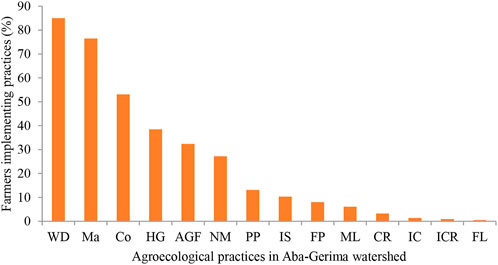
FIGURE 3. Agroecological practices for restoring degraded soils and improving agricultural productivity in Aba-Gerima watershed. WD refers to watershed development activities, Ma, manure; Co, compost; HG, Homegardening; AGF, agroforestry; NM, natural mating; PP, pit planting; IS, improved seeds; FP, feed production; ML, mulching; CR, crop rotation; IC, intercropping; ICR, incorporating crop residues; FL, fallowing.
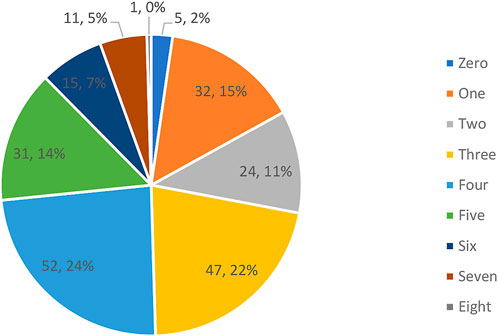
FIGURE 4. Number of agroecological practices implemented or adopted by a farmer in Aba-Garima watershed. The sum of percent values is more than 100%, as a farmer can adopt more than one agroecological practices.
Farmers realize the importance of agroecological practices through their own experiences. According to key informants, the implementation of watershed level agroecological practices such as the establishment of exclosure and implementation of soil and water conservation (SWC) measures are attributable to their role in avoiding further degradation of native vegetation and restoring ecosystem services, reducing soil erosion, improving soil fertility and soil moisture content, and extending the opportunity for dry season irrigation and reducing the loss of crop yield due to moisture stress. They also appreciate forage development including those integrated with physical SWC measures for addressing shortage of livestock feed, increasing livestock productivity, and improving income, livelihood, and food security. Key informants further elaborated that farm level agroecological practices such as application of compost and manure and establishment of home gardens support to improve soil fertility and increase productivity of crops and fruits.
Findings from focus group discussions also underscored the importance of agroecological practices. For example, participants of FGD revealed that agroecological practices are key to increasing income and ensuring food and nutrition security. Farmers appreciate the value of some practices more than other practices depending on their household needs and farming objectives. Different groups of beneficiaries, including male and female farmers, rich and poor farming households, cash crop and subsistence farmers consistently identified home gardening and improved crop varieties as the agroecological practices they rely on to earn more money. They value home gardening for generating more money, in that they cultivate their main cash crops, including Khat (Catha edulis), Mango (Mangifera indica), Coffee and Gesho (Rhamnus prinoides) through home gardening. They harvest these cash crops several times per year, and they sell them to get income. Thus, home gardening facilitates their income-generating activities. Regarding improved crop varieties, they appreciate improved varieties for their productivity and providing them with more yield. The capacity to produce more yield through improved seeds means having more crops to sell in the market, thereby enabling farmers to earn more money.
Similarly, the different groups of beneficiaries, as well as different categories of non-beneficiaries, commonly identified improved crop varieties and home gardening as practices that ensure their household’s food security. Farmers reported that crop production based on improved crop variety ensures household’s food security, in that improved varieties increase crop productivity. By using improved varieties, they indicated that farmers could get surplus production that can help them fulfill their households’ food consumption. Farmers’ explanations of the importance of home gardening for food security suggest that home gardening serves household food security in two ways. First, through home gardening, farmers produce cash crops such as Khat (Catha edulis), Coffee and Gesho (Rhamnus prinoides), and other vegetables and fruits that can be sold and provide income. The money acquired through home gardening can be used to buy food items and crops which cannot be available from their own production. In this way, home gardening supports a household’s food security. Secondly, vegetables produced through home gardening can be used for domestic/household food consumption and thus support household’s food security. Similarly, fruits produced through home gardening contribute to household’s food consumption. Farmers indicated that when there is no cooked food at home, household members, particularly children satisfy their interim meals by eating fruits. Thus, home gardening contributes to household’s food security in multiple ways, thereby positively influencing farmers’ decision-making and encouraging them to keep implementing this practice.
The diverse perceived environmental, socio-economic, and livelihood benefits of agroecological practices mentioned by survey respondents, key informants and focus group discussions participants are consistent with the findings of some studies conducted in Ethiopia and elsewhere in the world. For example, a review by Paracchini et al. (2020) consulted 172 documents and indicated the positive contribution of agroecological practices such as agroforestry, intercropping, and the use of diversified crop rotations to food security, income, and diversified diets. A review by Kefale (2020) demonstrated that home gardening in Ethiopia is realized as an important self-sustaining agroecosystem with the dual function of production and on-farm conservation of agrobiodiversity. Kerr et al. (2021) documented evidence of positive outcomes in the use of agroecological practices on food security and nutrition of households in low and middle-income countries.
The farm and watershed level agroecological practices identified as very common, somewhat common, and uncommon practices are implemented in the watershed either by replacing existing agricultural practices or as an additional activity or in combination with the existing practices. For example, exclosures are usually implemented on the portion of communal grazing land, suggesting that there is a shift from free grazing to a cut and carry system (i.e., implemented by replacing existing practice). The production of fruits and vegetables around homesteads are implemented either in combination with existing activities and/or replacing the current production system that is largely crop production. Forage development on the banks of physical SWC measures is implemented in combination with other soil and water conservation measures. However, if it is implemented around homesteads, it is usually by replacing other activities such as crop or vegetable production. Compost is an addition to the traditional manure utilization. Agroforestry is implemented by augmenting existing practices or by replacing field crop production. The physical (e.g., bunds and terraces) and biological (e.g., planting of forage trees and grasses) SWC measures are usually implemented by replacing crop production.
The modalities of the implementation of farm and watershed level agroecological practices in the watershed is linked to farmers priorities and tradeoffs, including the short-term economic benefits of the practices. Pursuing watershed level agroecological practices in the study area is mainly attributed to the purposes of livelihood diversification and protection of the environment. The implementation of diverse agroecological practices in the watershed suggests farmers’ interest on these practices and the importance of the practices to addressing both environmental and socio-economic issues.
Agricultural context, trends, and challenges in the Aba-Garima watershed
The results of key informant interviews and household surveys indicated that the agricultural system is characterized by mixed crop-livestock system. The main crops grown are maize (Zea mays), finger millet (Eleusine coracana) and Teff (Eragrostis tef). The cultivation of Barley (Hordeum vulgare), which was common a decade ago, is decreasing due mainly to severe attacks by birds and shortages of labor to protect the crop from bird attacks. Key informants indicated that Faba bean (Vicia faba), Field pea (Pisum sativum), Nug (Guizotia abyssinica), and linseed (Linum usitatissimum) are largely abandoned due mainly to shortages of land, while they were commonly cultivated 10–20 years ago. These observed changes in the agricultural system, along with the focus of farmers in addressing food security through cultivating limited major crops and the increasing shortages of land, could influence the adoption of agroecological practices such as intercropping with leguminous plants and crop rotation.
During focus group discussions, farmers also indicated that the constant threat imposed by birds attacking crop fields discouraged intercropping practices. This in turn limits the capacity of farmers to achieve food and nutrition security. In line with this, a recent review by Kerr et al. (2021), based on 55 case studies, found evidence of positive outcomes in the use of agroecological practices on food and nutrition security of households. This suggests that the extension service in Aba-Gerima watershed needs to exert efforts to address the existing challenges and promote the implementation of site-specific agroecological practices to ensure better food and nutrition security.
In addition, most farmers in the Aba-Garima watershed have shifted their practice of crop production from growing food crops to a less agroecological practice, Khat (Catha edulis) cultivation. This is also supported by the land use and land cover change analysis (i.e., Khat plantation displayed 370% increase in 16 years: Figure 5; Table 3). This situation suggests that conditions that can facilitate more remunerative agriculture and better income from farming are required to promote agroecological practices and protect or maintain ecosystem and sustain related natural resource management interventions.
Other observed changes in the agricultural sector over a period of 20 years include 1) expansion of fruit and vegetable production around homesteads, 2) introduction of improved farm management practices such as row planting of maize and Teff, and use of inorganic fertilizers and improved crop and livestock varieties, 3) stall feeding for dairy development and livestock fattening, and decreasing livestock number per household, 4) population growth (e.g., the number of households increased from 460 in 2011/12 to 540 households in 2020), 5) the introduction of integrated watershed development activities (e.g., exclosures, stall feeding), and 6) use of improved farm implements such as threshers.
Some of these observed changes such as the production of fruits and vegetables around homesteads, production of forage trees and grasses, and the practice of stall-feeding are recent phenomenon, mainly introduced in the past 10–15 years. Agroforestry is also practiced by farmers for feed, energy, and income generation. The majority of the key informants attributed the observed changes in the agricultural system to government agricultural extension strategies and directives such as community-based watershed development activities, improved farm management (e.g., row planting, use of improved varieties), and delivery of agricultural inputs such as improved crop varieties and fertilizer. However, some of the recent phenomenon, for example, the expansion of ‘Khat’ plantation is mainly attributed to market incentives and the influence of farming practices that generate short-term economic benefits. Most of the observed changes (excluding the expansion of Khat plantation) in the watershed could be considered as agroecological practices which have the potential to address environmental and social issues within food production (Kerr et al., 2021). Such positive changes could be an opportunity to promote and expand agroecological practices in the watershed, as it helps to grow and sustain an ecologically oriented and skilled workforce (Carlisle et al., 2019).
Key informants and household surveys revealed that the agricultural system in the study area is constrained by both environmental and human factors. Particularly, increased costs of agricultural inputs such as fertilizers, unregulated application of agrochemicals, pests, diseases, erratic rainfall, deforestation, and other socio-economic factors including migration of active labor force, shortage of livestock feed, and poor market access and research–extension linkage are the key challenges of the agricultural system.
The results of household surveys indicated that farmers rely on extension service as a primary source of information compared to other means such as self-experience, asking peers and media. However, it did not influence farmers’ behavior to refrain from using chemicals to control weed and pests. In other words, farmers who receive primary information from extension service still prefer using chemicals (Table 4). Farmers who use chemicals as weed and pest control method displayed significantly higher livestock holdings, more engagement in Khat plantation, and possession of a higher number of reproductive cattle compared to those who do not use chemicals as pest control method (Table 4). This suggests that household’s increasing engagement in remunerative agriculture (e.g., Khat plantation) may lead to less reliance on agroecological practices. This in turn indicates that economic factors are one of the key components influencing the adoption of agroecological practices (Punzano et al., 2022). Household income could also influence the use of labor-intensive methods such as crop rotation, as households with better income usually prefer using chemical to protect pests and diseases. This was supported by the fact that households with higher income do not use crop rotation to control weeds and pests because it requires additional labour (Table 4).
Heterogeneity of farming households and farms and variations in AE practices
The results of FGD revealed that there are differences and similarities among different households in terms of agroecological practices they prefer to adopt. The participants of FGD in the beneficiary group reported that fallowing is their least likely used agroecological practice, whereas non-beneficiaries reported that exclosure is their least likely used practice. Although exclosure was consistently identified by non-beneficiaries as the practice they would be least likely to use, some groups have different perspectives. Female farmers in this group identified SWC measure as the practice they would be least interested to use, while rich farmers identified fallowing as the least likely used practice.
The beneficiaries attributed the least likely use of fallowing to shortage of land and small landholdings. However, some groups within beneficiaries have different perspectives. For example, female-headed, poor, and cash crop-oriented households perceived that they would use all identified practices. It seems that these different categories of beneficiary farmers were indicating that they could use all practices if they were not constrained by different household’s socio-economic conditions. Non-beneficiaries attributed the least likely use of exclosures to the lack of communal grazing lands to participate in exclosure practices (mainly mentioned by male and poor farmers) and lack of collective action and regulations to protect exclosure (mainly mentioned by both cash crop and subsistent oriented farmers). Female farmers in the non-beneficiaries group attributed the least likely use of SWC to high labor demands related to digging soil, while the rich farmers pointed out the problem of lack of land for practicing fallowing.
Beneficiaries and non-beneficiaries also differed in their views regarding the practices they would be most likely to use. The beneficiaries reported that exclosure and production of livestock feed are the practices they would be most interested to use. On the other hand, non-beneficiaries indicated that home gardening is the practice they would most likely use. Regarding exclosure, the analysis of the responses of beneficiaries suggests that the diverse environmental (e.g., restoring vegetation, moderating microclimate) and livelihood (e.g., increased access to grass production) benefits attracted them to practice it. However, different socio-economic groups perceived different advantages associated with exclosure. Male farmers focused on the advantages of incentives associated with exclosure management, female farmers focused on environmental benefits in the form of rain, poor farmers focused on the benefits of better access to livestock feed, while cash crop and subsistence farmers focused on proximity issues. Regarding the production of livestock feed on bunds, the preference of beneficiaries to this practice relates to access to project seedlings and restricted use of livestock feed. The preference of non-beneficiaries to home gardening relates to the importance of home gardening for producing vegetables and fruits that can be used for sale as well as home consumption. Besides, it is practiced near home, and farm activities related to it can be done along with other household activities.
Such differences are also supported by the results of key informant interviews which revealed that participation in agroecological practices varies with access to and use of resources (e.g., land and water), knowledge, level of poverty, interest/aspiration, and project support. For example, exclosure is practiced by all farmers who had access to use communal grazing lands. Community members at large participate in implementing SWC measures, as it is partly enforced by the government. Members of the community living in the kebele also participate in SWC measures though not included in the watershed boundary. The production of fruits and vegetables around homestead is practiced by those having land, water for irrigation, having the experience of doing it, and those who can undertake the recommendations specified by extension workers. The key informants stressed that knowledge and experience is key in adopting and implementing agroecological practices, while having access to resources (land, water, livestock) alone is not necessarily a determining factor.
Factors influencing farmers’ decision and their implementation of agroecological practices
Farmers indicated that some of the common and somewhat common agroecological practices are very difficult to start using for various constraining factors. These hindering factors include lack of access to water, shortage of money, and land and labor shortages. These constraining factors are differently associated with different practices, involving diverse perspectives of different socio-economic groups. Regarding home gardening, different categories of beneficiaries, including male and female farmers, rich and poor farmers, cash crop and subsistence farmers frequently identified shortage of water as one of the major factors inhibiting this practice. From the perspective of beneficiary farmer groups representing male, rich, cash crop, and subsistence farmers, land shortage also discourages farmers from practicing home gardening to earn more money. Regarding the implementation of improved crop varieties, farmers identified shortage of labor and lack of money as constraining factors. The discouraging factor of lack of money is particularly associated with improved varieties, as farm inputs related to this practice have to be bought and money is required to purchase them.
Regarding the physical SWC measures, the identified problems are related to lack of technical know-how, collaboration, and labor. For example, male headed households insisted that without proper guidance by agricultural experts, constructed bunds/terraces would end up being destructive by causing more runoff. Cash crop farmers also indicated that a professional is needed to use appropriate instruments and to properly layout the different SWC measures in a watershed. On the other hand, poor farming households and subsistence farmers particularly focused on labor constraints to start using the physical SWC measures. They indicated that the practice involves a lot of digging which is very challenging and requires more people to start using it. The issues discussed above support the indication of some studies conducted in the highlands of Ethiopia (e.g., Mekuriaw et al., 2018; Wordofa et al., 2020) that suggested that the active involvement of farmers and technical support from the government is crucial to start and sustain the implementation of physical SWC measures
The difficulty in implementing exclosures and its sustainability concern relates to the collective action requirement of exclosure practices versus the reluctance of individuals in committing themselves to collective activities. During FGDs, farmers indicated that achieving consensus among community members is difficult, as farmers have diverse interests on communal lands and the ways they would like to use them for grazing animals. While the collective action problem is largely mentioned by different groups of farmers, there can also be other factors that inhibit the practice of exclosures. Shortage of land can be another problem. This was particularly mentioned by female-headed households. They indicated that lack of private grazing lands and shortage of land for livestock grazing impose problems to start implementing exclosure. Birhane et al. (2017) demonstrated that the positive attitude of local communities towards exclosures is often challenged by shortages of livestock feed as a competing priority.
The difficulty in implementing compost as an agroecological practice and sustaining it is mainly attributed to the requirement of more labor for its preparation, lack of knowledge, and health concerns associated with the preparation process. Farmers further elaborated that knowledge or experience in making compost is key to determine how different elements, including leaves, ash, soil, and dung can be mixed to produce compost. For poor farming households, however, the problem is related to shortage of manure. Instead of preparing compost, these farmers prefer to use the small amount of dung available on daily basis for home gardening. In general, different groups of farmers prefer to use available manure (undecomposed manure) for vegetables, or they resort to using inorganic fertilizer. A study conducted in sub-Saharan Africa (Schader et al., 2021) reported that limited capacities, lack of appropriate inputs, and market access are major agronomic and institutional challenges of organic farming.
Farmers perceived that some agroecological practices require more labor than others although labor is one of the constraining factors for most of the common and somewhat common agroecological practices. During FGDs, farmers clearly indicated that SWC measures, home gardening, and compost involve more labor compared to other agroecological practices. This is based on their own experiences with the implementation of agroecological practices. Their perceptions and experiences regarding the labor demand of agroecological practices can significantly affect their continued engagement with these practices.
Thus, depending on different socio-economic characteristics of farming households, agroecological practices that appear common practices can be very difficult to use for some farmers, while it could be possible for other farmers. Even farmers who have already started employing some common agroecological practices may find it difficult to successfully implement them. In this case, commonly practiced agroecological practices may not necessarily mean they can be used sustainably. This raises an important issue regarding the sustainability of commonly implemented agroecological practices. Yet, it is also worth noting that similar agroecological practices identified by farmers as being difficult to start and difficult to use successfully does not necessarily mean that a given agroecological practice is difficult to use and difficult to succeed simultaneously. Instead, it means that for some groups of farmers, such agroecological practices are difficult to use even from the start, while other groups of farmers may find it difficult to continue with using them later.
Farmers also perceive that some agroecological practices are riskiest for household’s long-term food and financial security. During FGDs, intensive farming using inorganic input and the use of improved crop variety are reported to be risky for household’s food and financial security depending on certain circumstances. Reliance on these practices can be risky particularly in times of drought and hail occurrences. During such circumstances, farmers can lose not only the bought inputs but also their crop production, thereby affecting their household’s financial and food security. Farmers’ explanations also suggest that reliance on inorganic input can be risky, as they fear there will be shortage of fertilizer, while their land is increasingly getting dependent on fertilizer. Farmers who often face shortage of fertilizers and improved seeds would particularly experience this risk.
The results of focus group discussions on factors influencing farmers’ decision and their implementation of agroecological practices are supported by the results of MVP model analysis of household surveys. For example, the implementation of sustainable land management practices through watershed development activities was negatively influenced by age of household head (Table 5). This suggests that watershed development activities are labor-intensive and require more active labor and household’s decision to implement watershed development activities decreases as the household head or farm decision maker (s) get (s) older (Daniel and Mulugeta 2017; Mohammed et al., 2018). Family size, which is a proxy to availability of active labor significantly (p < 0.05) influenced the adoption or implementation of manure, Homegardening and watershed development activities. This suggests that families having more labor force are likely to adopt diverse agroecological practices. Although it was not significant at 5% level of significance, being male headed household had considerable positive influence (p < 0.1) on the adoption of manure and agroforestry practices. This suggests that male headed households possess more resources (e.g., livestock holding) and labor, which are key for the adoption of the agroecological practices. Similarly, engaging in remunerative agriculture (e.g., Khat plantation) had considerable positive influence on the adoption of manure and natural mating as an agroecological practice. This could be attributed to farmers interest to sustainably implement income generating activities through maintaining the fertility of farmlands and ensure household food security. The significantly positive relationship between Khat plantation and natural mating suggests the importance of remunerative agriculture to adopt diverse agroecological practices including livestock management. The significant (p < 0.01) negative relationship between Khat plantation and watershed development activities support the results of FGD and key informant interviews in that farmers engaged in remunerative agriculture give less focus on community-based sustainable land management practice.
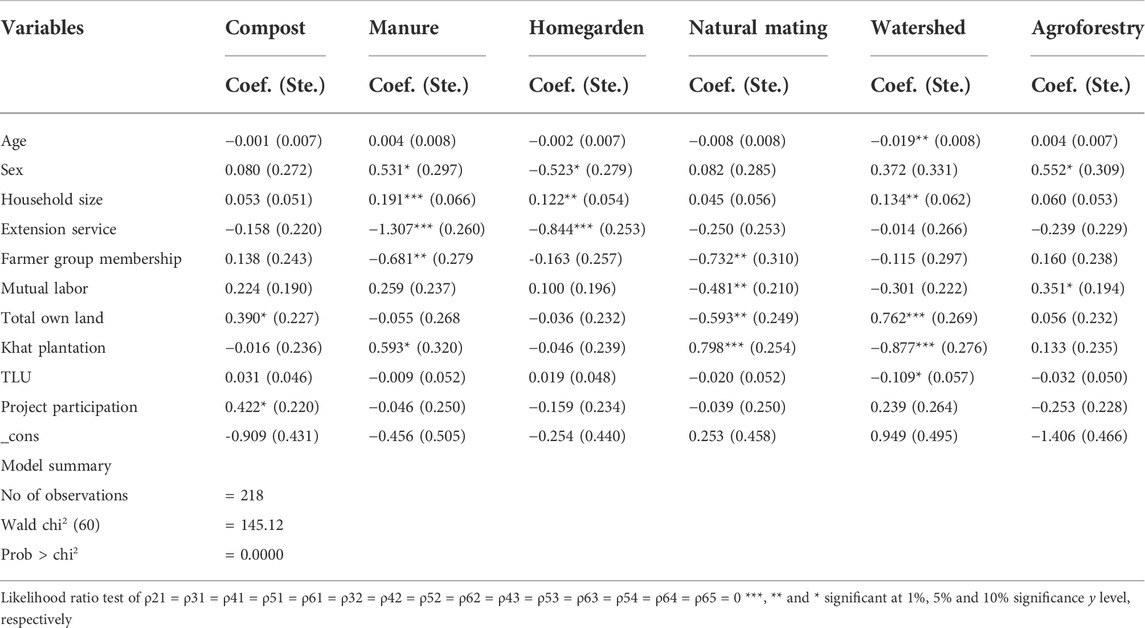
TABLE 5. Multivariate probit model results for factors influencing the use or implementation of agroecological practices1.
Unexpectedly, extension service negatively and significantly influenced the adoption of manure and home gardening (Table 5). This may suggest that the extension service is less focused on these agroecological practices while focusing more on government directives on increasing agricultural production through agricultural intensification and watershed development activities (e.g., implementation of landscape-level sustainable land management practices). Mutual labour positively and considerably influenced the implementation of agroforestry practices suggesting that the labour demand of agroecological practices can partly be addressed if collaboration among farmers is promoted in the study area. Project participation and total own land considerable influenced the application of compost, and project participation also positively influenced watershed development activities though the relationships was not significant (Table 5). Family size, which is a proxy to labour availability looks important for the implementation of most of the agroecological practices. In summary, the results of MVP model analyses of the survey data support that farmers who use or implement different agroecological practices differ in their household characteristics (e.g., family size, labor availability, livestock ownership) and farm characteristics (e.g., number of plots, land ownership, farm size) (Table 5).
The relationships among the identified agroecological practices were presented in Table 6. Five of the 15 tested interrelationships displayed positive and significant relationships (Table 6), indicating that these agroecological practices can be implemented jointly. The results indicated that compost (ρ1) and manure (ρ2); natural mating (ρ4) and manure (ρ2); natural mating (ρ4) and home garden (ρ3); watershed development activities (ρ5) and home garden (ρ3); and watershed development activities (ρ5) and natural mating (ρ4) are agroecological practices that can be implemented in combination. This is consistent with the results of key informant interviews and FGD in that agroecological practices implemented in the study area either in combination, as an additional practice or replacing existing practices.
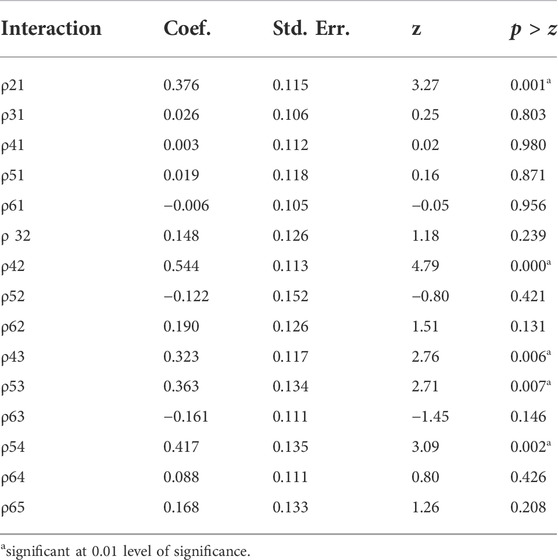
TABLE 6. Estimated covariance matrix of the regression equations between agroecological practices using MVP model.
Conclusion
The results of this study suggest that agroecological practices are part of the agricultural system in the study area. They significantly contribute to improving farming livelihoods by enhancing farmers’ ability to get higher income, achieve food security, and protect the environment. The adoption of diverse agroecological practices and the sustainability of implemented practices depend on differing households’ socio-economic situations and farm characteristics. Farming households may differ in terms of the adoption of agroecological practices, in that some households may have better capacity to adopt agroecological practices, while other households may lack capacity to adopt such practices. This is because farming households are not homogenous. There are also differences among farming households who have started implementing agroecological practices. Some continue with these practices, while others drop out at least some practices through the process. This shows that even implemented practices may not necessarily mean they can be used sustainably. Thus, efforts to improve the use of agroecological practices should consider strategies that can facilitate their adoption as well as sustained use. The factors influencing the implementation and sustainable use of agroecological practices are diverse and are associated with farming households’ typologies and types of agroecological practices. Economic benefits related to financial needs, household food security needs, and concern for environmental protection are the most important factors that influence farmers’ behavior in adopting agroecological practices. This calls for conditions that can facilitate more remunerative agriculture and better income while ensuring increased agricultural productivity and food production with reasonable ecological safety. This situation can promote agroecological practices, maintain ecosystem, and sustain related natural resource management interventions. Further research is needed to investigate in depth whether gender orientations and practices differ in terms of environmental impacts of agroecological practices. It is also worth mentioning that factors influencing the adoption of agroecological practices could vary with time with changes in household and farm characteristics as well as changes in other socio-ecological settings.
Data availability statement
The original contributions presented in the study are included in the article, further inquiries can be directed to the corresponding author.
Author contributions
All authors listed have made a substantial, direct, and intellectual contribution to the work, and approved it for publication.
Funding
The project was implemented by the Transformative Platform for Agroecology and funded by the Government of France.
Acknowledgments
We are grateful to the project “Documenting and evaluating the socio-economic viability of agroecological practices across Africa Project” for the financial support. We are also very grateful for the local communities involved in the study and local level practitioners who supported us during the design and implementation of the project.
Conflict of interest
The authors declare that the research was conducted in the absence of any commercial or financial relationships that could be construed as a potential conflict of interest.
Publisher’s note
All claims expressed in this article are solely those of the authors and do not necessarily represent those of their affiliated organizations, or those of the publisher, the editors and the reviewers. Any product that may be evaluated in this article, or claim that may be made by its manufacturer, is not guaranteed or endorsed by the publisher.
Footnotes
1Prior to interpreting model results, the validity of the model outputs or results were tested using Wald and Chi2 test (Table 5) and was detected that farmer’s choices among the six agroecological practices were not mutually exclusive or the decisions to choose and implement agroecological practices in the study area are interdependent. This supports the use of MVP model for the analysis.
References
Abebe, G., Tsunekawa, A., Haregeweyn, N., Takeshi, T., Wondie, M., Adgo, E., et al. (2020). Effects of land use and topographic position on soil organic carbon and total nitrogen stocks in different agro-ecosystems of the Upper Blue Nile Basin. Sustainability 12 (6), 2425. doi:10.3390/su12062425
Abeje, M. T., Tsunekawa, A., Adgo, E., Haregeweyn, N., Nigussie, Z., Ayalew, Z., et al. (2019). Exploring drivers of livelihood diversification and its effect on adoption of sustainable land management practices in the Upper Blue Nile Basin, Ethiopia. Sustainability 11 (10), 2991. doi:10.3390/su11102991
Ahmed, M. H., and Mesfin, H. M. (2017). The impact of agricultural cooperatives membership on the wellbeing of smallholder farmers: Empirical evidence from eastern Ethiopia. Agric. Food Econ. 5 (1), 6–20. doi:10.1186/s40100-017-0075-z
Asrat, P., and Simane, B. (2017). Household-and plot-level impacts of sustainable land management practices in the face of climate variability and change: Empirical evidence from dabus sub-basin, blue nile river, Ethiopia. Agric. Food Secur. 6 (1), 61–12. doi:10.1186/s40066-017-0148-y
Ayalew, A. (2011). Construction of soil conservation structures for improvement of crops and soil productivity in the Southern Ethiopia. J. Environ. Earth Sci. 1 (1), 21–29.
Barrios, E., Gemmill-Herren, B., Bicksler, A., Siliprandi, E., Brathwaite, R., Moller, S., et al. (2020). The 10 elements of agroecology: Enabling transitions towards sustainable agriculture and food systems through visual narratives. Ecosyst. People 16 (1), 230–247. doi:10.1080/26395916.2020.1808705
Birhane, E., Mengistu, T., Seyoum, Y., Hagazi, N., Putzel, L., Rannestad, M. M., et al. (2017). Exclosures as forest and landscape restoration tools: Lessons from tigray region, Ethiopia. Int. For. Rev. 19 (4), 37–50. doi:10.1505/146554817822330498
Branca, G., Lipper, L., McCarthy, N., and Jolejole, M. C. (2013). Food security, climate change, and sustainable land management. A review. Agron. Sustain. Dev. 33 (4), 635–650. doi:10.1007/s13593-013-0133-1
Carlisle, L., Montenegro de Wit, M., DeLonge, M. S., Iles, A., Calo, A., Getz, C., et al. (2019). Transitioning to sustainable agriculture requires growing and sustaining an ecologically skilled workforce. Front. Sustain. Food Syst. 3, 96. doi:10.3389/fsufs.2019.00096
Daniel, A., and Mulugeta, N. (2017). Factors influencing adoption of SWC practices: The case of Wereillu woreda (district), South Wollo zone, Amhara region, Ethiopia. Int. Soil Water Conservation Res. 5 (4), 273–279. doi:10.1016/j.iswcr.2017.10.002
Dellink, R. B., and Ruijs, A. (2008). Economics of poverty, environment, and natural-resource use. Wageningen UR Frontis Series. Springer Science & Business Media.
Etsay, H., Negash, T., and Aregay, M. (2019). Factors that influence the implementation of sustainable land management practices by rural households in Tigrai region, Ethiopia. Ecol. Process. 8 (1), 14–16. doi:10.1186/s13717-019-0166-8
Haileslassie, A., Priess, J. A., Veldkamp, E., and Lesschen, J. P. (2006). Smallholders’ soil fertility management in the central highlands of Ethiopia: Implications for nutrient stocks, balances, and sustainability of agroecosystems. Nutr. Cycl. Agroecosyst. 75 (1), 135–146. doi:10.1007/s10705-006-9017-y
Headey, D., Dereje, M., and Taffesse, A. (2014). Land constraints and agricultural intensification in Ethiopia: A village-level analysis of high-potential areasfication in Ethiopia: A village-level analysis of high-potential areas. Food Policy 48, 129–141. doi:10.1016/j.foodpol.2014.01.008
Kefale, B. (2020). Homegarden agroforestry in Ethiopia-A review. Int. J. Bio-resource Stress Manag. 11 (4), 345–352. doi:10.23910/1.2020.2118d
Kemp, D. R., Guodong, H., Xiangyang, H., Michalk, D. L., Fujiang, H., Jianping, W., et al. (2013). Innovative grassland management systems for environmental and livelihood benefits. Proc. Natl. Acad. Sci. U. S. A. 110 (21), 8369–8374. doi:10.1073/pnas.1208063110
Kerr, R. B., Madsen, S., Stüber, M., Liebert, J., Enloe, S., Borghino, N., et al. (2021). Can agroecology improve food security and nutrition? A review. Glob. Food Secur. 29, 100540. doi:10.1016/j.gfs.2021.100540
Mekuriaw, A., Heinimann, A., Zeleke, G., and Hurni, H. (2018). Factors influencing the adoption of physical soil and water conservation practices in the Ethiopian highlands. Int. Soil Water Conservation Res. 6 (1), 23–30. doi:10.1016/j.iswcr.2017.12.006
Méndez, V., Bacon, C., and Cohen, R. (2013). Agroecology as a transdisciplinary, participatory, and action-oriented approach. Agroecol. Sustain. Food Syst. 37 (1), 3–18. doi:10.1080/10440046.2012.736926
Mohammed, G., Yan, D., Wang, H., Basaznew, A., Mersha, C., and Genanew, A. (2018). Determinant factors influencing crop production and adoption of SWC practices in Semein Mountain National Park, Ethiopia. Int. J. Environ. Sci. Nat. Resour. 13 (2), 555858. doi:10.19080/IJESNR.2018.13.555858
Nhemachena, C., and Hassen, R. (2007). Micro-level analysis of farmers’ adaptation to climate change in Southern africa. IFPRI Discussion Paper 00714.
Oteros-Rozas, E., Ravera, F., and García-Llorente, M. (2019). How does agroecology contribute to the transitions? Sustainability 11 (16), 4372. doi:10.3390/su11164372
Paracchini, M. L., Justes, E., Wezel, A., Zingari, P. C., Kahane, R., Madsen, S., et al. (2020). Agroecological practices supporting food production and reducing food insecurity in developing countries. A study on scientific literature in 17 countries. Luxembourg: European Union.
Punzano, P. A., Rahmani, D., and Cabello Delgado, M. D. M. (2022). Adoption and diffusion of agroecological practices in the horticulture of catalonia. Agronomy 11 (10), 1959. doi:10.3390/agronomy11101959
Quinlan, R. J., Quinlan, M. B., Dira, S., Caudell, M., Sooge, A., and Assoma, A. A. (2015). Vulnerability and resilience of Sidama enset and maize farms in Southwestern Ethiopia. J. Ethnobiol. 35 (2), 314–336. doi:10.2993/etbi-35-02-314-336.1
Schader, C., Heidenreich, A., Kadzere, I., Egyir, I., Muriuki, A., Bandanaa, J., et al. (2021). How is organic farming performing agronomically and economically in sub-Saharan Africa? Glob. Environ. Change 70, 102325. doi:10.1016/j.gloenvcha.2021.102325
Schmidt, E., and Tadesse, F. (2019). The impact of sustainable land management on household crop production in the Blue Nile Basin, Ethiopia. Land Degrad. Dev. 30, 777–787. doi:10.1002/ldr.3266
Seid, H. (2015). Disadoption, substitutability, and complementarity of agricultural technologies: A random effects multivariate probit analysis. Environ. Dev. 2015, 15–26.
Sinclair, F., Wezel, A., Mbow, C., Chomba, S., Robiglio, V., and Harrison, R. (2019). The contribution of agroecological approaches to realizing climate-resilient agriculture. Rotterdam and Washington, DC: Agroecology Knowledge Hub.
Sutton, M. A., Bleeker, A., Howard, C. M., Erisman, J. W., Abrol, Y. P., Bekunda, M., et al. (2013). Our nutrient world. The challenge to produce more food & energy with less pollution. Edinburgh, United Kingdom: Centre for Ecology and Hydrology (CEH).
Teixeira, H. M., Van den Berg, L., Cardoso, I. M., Vermue, A. J., Bianchi, F. J., Peña-Claros, M., et al. (2018). Understanding farm diversity to promote agroecological transitions. Sustainability 10 (12), 4337. doi:10.3390/su10124337
Tittonell, P., Piñeiro, G., Garibaldi, L. A., Dogliotti, S., Olff, H., and Jobbagy, E. G. (2020). Agroecology in large scale farming—A research agenda. Front. Sustain. Food Syst. 214, 584605. doi:10.3389/fsufs.2020.584605
Wezel, A., Bellon, S., Doré, T., Francis, C., Vallod, D., and David, C. (2009). Agroecology as a science, a movement, and a practice. A review. Agron. Sustain. Dev. 29 (4), 503–515. doi:10.1051/agro/2009004
Wezel, A., Casagrande, M., Celette, F., Vian, J. F., Ferrer, A., and Peigné, J. (2014). Agroecological practices for sustainable agriculture. A review. Agron. Sustain. Dev. 34 (1), 1–20. doi:10.1007/s13593-013-0180-7
Keywords: agroecological practices, environmental protection, farm characteristic, food security, household characterstics, income
Citation: Mekuria W, Dessalegn M, Amare D, Belay B, Getnet B, Girma G and Tegegne D (2022) Factors influencing the implementation of agroecological practices: Lessons drawn from the Aba-Garima watershed, Ethiopia. Front. Environ. Sci. 10:965408. doi: 10.3389/fenvs.2022.965408
Received: 09 June 2022; Accepted: 02 September 2022;
Published: 26 September 2022.
Edited by:
Elias T. Ayuk, Independent Researcher, Accra, GhanaReviewed by:
Mehmet Ali Çullu, Harran University, TurkeyGideon Danso-Abbeam, University for Development Studies, Ghana
Keshav Lall Maharjan, Hiroshima University, Japan
Copyright © 2022 Mekuria, Dessalegn, Amare, Belay, Getnet, Girma and Tegegne. This is an open-access article distributed under the terms of the Creative Commons Attribution License (CC BY). The use, distribution or reproduction in other forums is permitted, provided the original author(s) and the copyright owner(s) are credited and that the original publication in this journal is cited, in accordance with accepted academic practice. No use, distribution or reproduction is permitted which does not comply with these terms.
*Correspondence: Wolde Mekuria, dy5ib3JpQGNnaWFyLm9yZw==
 Wolde Mekuria
Wolde Mekuria Mengistu Dessalegn
Mengistu Dessalegn Dagninet Amare
Dagninet Amare Beyene Belay2
Beyene Belay2 Banchiamlak Getnet
Banchiamlak Getnet Gonche Girma
Gonche Girma Desalegn Tegegne
Desalegn Tegegne